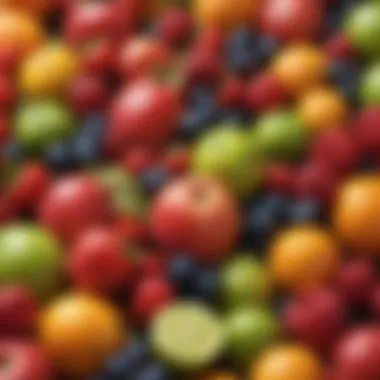Foods Rich in Polyphenols: An Insightful Exploration


Intro
Polyphenols are a diverse group of naturally occurring compounds found in plant-based foods. Their prominence in discussions around diet and nutrition is well-deserved, given their potential health benefits. These compounds demonstrate strong antioxidant properties and may contribute to reducing the risk of various chronic diseases. Understanding the types of polyphenols and their dietary sources can empower individuals to make informed choices about their nutrition.
In this exploration of polyphenol-rich foods, we will take a closer look at what these compounds are, categorize their many forms, and list several foods that are known to be abundant in polyphenols. By the end of this article, you should have a clear understanding of how to incorporate more polyphenol-rich foods into your daily meals and enhance your overall wellness.
Understanding Polyphenols
Exploring the world of polyphenols is essential for grasping their significance in our diets and overall health. Polyphenols are naturally occurring compounds found extensively in plants. They play a crucial role in plant defense against diseases, and their consumption can bring numerous benefits to human health. By gaining insight into polyphenols, we can appreciate their role in boosting antioxidant levels, enhancing heart health, and potentially reducing disease risk.
Definition and Classification
Polyphenols are a diverse group of chemical compounds characterized by the presence of multiple phenol units. They are primarily classified into two main categories: flavonoids and non-flavonoids. Flavonoids include compounds such as quercetin and catechins, while non-flavonoids consist of stilbenes and phenolic acids. Each category boasts various subclasses, illustrating the complexity and richness of polyphenol structures.
In dietary terms, polyphenols are often associated with colorful fruits, vegetables, whole grains, nuts, and beverages like tea and wine. Understanding their classification helps in identifying the food sources that are rich in these compounds.
Polyphenols: Chemical Structure
The chemical structure of polyphenols is intricate and responsible for their unique health properties. Typically, they consist of a basic structure of phenolic rings, which may vary in the number and arrangement of hydroxyl groups. This variability influences their solubility and biological activity within the body.
Polyphenols can act as antioxidants, neutralizing free radicals and thus reducing oxidative stress. Their structure allows for interaction with enzymes and receptors in the body, which is critical in modulating several physiological responses. Understanding the chemical structure can lead to better insights into their roles in nutrition and health.
Role of Polyphenols in the Human Body
Polyphenols have been shown to influence various bodily functions. Their role as antioxidants helps protect against oxidative damage, which is a contributor to chronic diseases and aging. Moreover, they are known to reduce inflammation, an essential factor in many health conditions such as heart disease and arthritis.
Recent studies suggest that polyphenols can positively affect gut microbiota, enhancing gut health and digestive function. This interaction can lead to improved nutrient absorption and overall wellness.
The significance of polyphenols in our diet cannot be overstated; they are essential allies in promoting health and preventing disease.
Health Benefits of Polyphenols
The discussion on polyphenols is not merely academic; it holds significant relevance for dietary choices. The potential health benefits of consuming polyphenol-rich foods can impact various aspects of well-being. Understanding these benefits can help individuals make informed dietary decisions. Many studies suggest that polyphenols contribute positively to overall health, influencing key areas such as antioxidant activity and inflammation reduction. This section will explore these benefits in detail, providing a clear understanding of how polyphenols can enhance health.
Antioxidant Properties
Polyphenols are chiefly known for their antioxidant properties. Antioxidants are compounds that help combat oxidative stress caused by free radicals. These free radicals can lead to cellular damage and play a role in aging and various diseases. By consuming polyphenol-rich foods, individuals may help neutralize these harmful molecules.
Researchers indicate that regular intake of antioxidants can reduce the risk of chronic diseases, promoting longevity. Foods high in polyphenols, such as dark chocolate and berries, are great choices for individuals seeking to boost their antioxidant intake.
Anti-Inflammatory Effects
Another significant benefit of polyphenols is their anti-inflammatory effects. Chronic inflammation is linked to numerous health issues, including heart disease and certain cancers. Polyphenols can inhibit the production of inflammatory markers in the body, thereby reducing inflammation. This is particularly relevant for those with inflammatory conditions or those at risk for inflammatory diseases. Integrating foods like red wine and green tea into one's diet can be beneficial for managing inflammation levels.
Potential Disease Risk Reduction
Polyphenols may also play a role in reducing the risk of various diseases. Research suggests a correlation between high polyphenol intake and lower incidences of diseases such as diabetes, cardiovascular diseases, and some types of cancer. The protective effects of polyphenols can be attributed to their overall influence on metabolic processes and cellular health.
Including polyphenol-rich foods like grapes and onions could contribute to better disease outcomes. This makes them a worthwhile addition to a balanced diet.
Impact on Gut Health


Lastly, polyphenols have a positive impact on gut health. The human gut microbiome consists of numerous bacteria that play key roles in digestion and overall health. Polyphenols can promote the growth of beneficial gut bacteria while inhibiting harmful strains. This balance is crucial for maintaining digestive health and preventing gastrointestinal disorders.
Foods such as apples and flaxseeds can enhance gut health due to their rich polyphenol content. Therefore, those seeking to improve gut health should consider incorporating these foods into their diet.
Integrating polyphenol-rich foods into your diet can lead to significant health improvements and an overall better quality of life.
Sources of Polyphenols in Diet
The inclusion of polyphenol-rich foods in our diets is essential. These compounds play a significant role in promoting health and wellness. Polyphenols are prevalent in various food groups, making it easier to incorporate them into everyday meals. Understanding these sources helps individuals make informed dietary decisions.
Diverse food sources provide a range of health benefits associated with polyphenols. These benefits include antioxidant effects, reduced inflammation, and potential reductions in chronic disease risks. It is valuable to know where to find polyphenols to maximize their effects on health.
Fruits High in Polyphenols
Apples
Apples are a well-known source of polyphenols. They contain quercetin, a type of flavonoid, which is beneficial for heart health. The high fiber content in apples complements their polyphenol richness, promoting digestive health. The skin of apples holds a significant concentration of these compounds, making them even more nutritious. Eating apples regularly may support overall wellness and provide essential nutrients in the diet.
Berries
Berries, particularly blueberries and blackberries, are often celebrated for their high polyphenol content. These fruits are rich in anthocyanins, a subclass of polyphenols linked to various health benefits. They have shown potential in improving cognitive function and offering protection against oxidative stress. Fresh berries are easy to include in many dishes, enhancing flavor and nutrition.
Grapes
Grapes, especially red and black varieties, are another excellent source of polyphenols. They contain resveratrol, which is associated with heart health and may have anti-aging properties. Grapes can be consumed as snacks or used in various dishes, increasing their versatility in the kitchen. Including grapes in the diet can be an enjoyable way to access their health benefits.
Vegetables Rich in Polyphenols
Onions
Onions are often overlooked, but they are potent sources of flavonoids, specifically quercetin. This polyphenol has been studied for its anti-inflammatory effects. Onions can be added to a variety of meals, providing flavor while adding nutritional value. However, they can sometimes cause digestive discomfort for sensitive individuals, which is worth considering.
Spinach
Spinach is not only rich in vitamins and minerals but also contains notable polyphenols, such as flavonoids. Including spinach in the diet can contribute to antioxidant and anti-inflammatory effects. Raw or cooked, spinach can be easily incorporated into various recipes, though cooking may reduce some of its polyphenol content. Fresh spinach has advantages for those looking to maximize their intake.
Artichokes
Artichokes are a unique vegetable that provides a high concentration of polyphenols. They contain cynarin and other compounds that may support liver health. Artichokes can be prepared in several ways—steamed, grilled, or used in dips. On the downside, they can be more challenging to prepare compared to other vegetables, which may discourage some.
Nuts and Seeds
Walnuts
Walnuts are significant for those seeking polyphenols in their diet. They contain high levels of ellagitannins, which may support heart health and provide anti-inflammatory benefits. The rich, nutty flavor of walnuts makes them a great addition to salads and baked goods. While walnuts are nutritious, they are also calorie-dense and should be consumed in moderation.
Flaxseeds
Flaxseeds are not only high in omega-3 fatty acids but also contain lignans, a type of polyphenol. These can contribute to hormone balance and overall health. Flaxseeds in ground form can easily be added to smoothies, oatmeal, or baked goods. However, they must be stored correctly to prevent rancidity and maintain their nutritional value.
Dark Chocolate


Dark chocolate is often celebrated for its polyphenol content. Specifically, it is rich in flavanols, which may offer heart-health benefits. Choosing higher cocoa content (70% or more) maximizes the health benefits associated with dark chocolate. However, the presence of sugar and fat should be considered, making moderation key in its consumption.
Beverages Containing Polyphenols
Tea
Tea, especially green and black varieties, is a significant source of polyphenols. These beverages provide catechins, known for their antioxidant properties. Drinking tea regularly may support cardiovascular health and enhance overall wellness. However, excessive consumption can lead to caffeine sensitivity for some individuals, requiring moderation.
Coffee
Coffee is another popular drink rich in polyphenols, notably chlorogenic acids. Moderate coffee consumption is associated with several health benefits, including improved mental alertness. However, it should be noted that coffee can interfere with sleep patterns if consumed too late in the day.
Red Wine
Red wine is well-regarded for its resveratrol content, a polyphenol linked to heart health benefits. The moderate consumption of red wine, particularly during meals, can be part of a balanced diet. Nonetheless, it is important to be cautious as excessive alcohol intake can lead to negative health outcomes.
Cooking with Polyphenol-Rich Ingredients
Cooking with polyphenol-rich ingredients is a crucial aspect of enhancing one's diet. Understanding how to effectively integrate these food items into daily meals can maximize their health benefits. Polyphenol-rich foods do not only contribute to better overall wellbeing, but they also add flavor, color, and texture to various dishes. Here, we analyze different methods of including these foods in daily cooking practices, each with their unique advantages and considerations.
Incorporating Fruits and Vegetables
Raw Preparations
Raw preparations of fruits and vegetables allow for maximum preservation of polyphenols. This method retains most of the nutrients and natural flavors inherent in these foods. For instance, apples, berries, and spinach can lose some of their beneficial compounds when cooked at high temperatures. Eating them raw can be a beneficial choice for salad lovers or those who enjoy smoothies.
Raw foods also offer the advantage of convenience. They require little to no preparation, making it easy to maintain a diet rich in polyphenols. It’s important to wash fruits and vegetables thoroughly to remove any pesticide residues. However, a drawback might be the digestive discomfort some individuals experience with raw foods, especially if they are not accustomed to high-fiber diets.
Cooked Dishes
Cooking can enhance the bioavailability of some polyphenols, making them easier to absorb into the body. For example, steaming broccoli or sautéing onions can release beneficial compounds that might not be as accessible when the vegetables are raw. Cooked dishes, such as stir-fries or soups, can also combine multiple polyphenol sources, ensuring a variety of nutrients in one meal. While cooked preparations may reduce certain polyphenolic content, they can still retain significant health benefits. A downside is that overcooking can lead to nutrient loss; hence, quick cooking methods are often recommended.
Using Nuts and Seeds in Recipes
Baking
Incorporating nuts and seeds in baking introduces not just polyphenols but also healthy fats and protein. Walnuts, for example, offer a rich source of polyphenols and can be added to breads or muffins, enhancing nutrition. Baking can also bring out deeper flavors in these ingredients, which may otherwise be overlooked.
A notable characteristic of baking is its ability to create comforting, familiar foods that are enhanced with nutritional value. However, one must be mindful of portion sizes because even healthy fats can lead to overeating.
Salads
Including nuts and seeds in salads can elevate both taste and nutritional content. Flaxseeds and walnuts add crunch, while also providing health benefits such as improved heart function. Salads are typically low in calories but high in nutrients; hence, the addition of these elements can make them more satisfying.
A unique advantage of salads is versatility. They can be tailored to suit individual preferences or dietary needs. Nonetheless, it is important to dress salads carefully, as overly rich dressings can detract from their health benefits.
Beverage Pairings
Tea and Food Pairings
Pairing meals with tea can be a strategic way to enhance polyphenol intake. Different types of tea, such as green tea or black tea, contain varying levels of polyphenols that can complement the flavors in food. For instance, green tea is often enjoyed alongside sushi or Asian cuisine.
The characteristic of tea as a beverage is its low-caloric nature, making it a healthy choice to accompany meals. An interesting feature of tea is the way it can alter the absorption of polyphenols from food, which is another factor to consider when planning meals.
Wine with Meals
Red wine is often cited for its high polyphenol content, particularly resveratrol. When consumed in moderation, wine can complement meals beautifully, enhancing both flavors and potential health benefits. It’s notable that different wines pair well with various dishes, making wine a dynamic addition to dining experiences. However, the alcohol content in wine presents a caution. Overindulgence can outweigh the health benefits associated with its polyphenol content. Thus, moderation and awareness are critical when incorporating wine into a diet rich in polyphenols.


Special Considerations for Polyphenol Intake
When integrating polyphenols into one's diet, it is vital to consider several factors that can influence their absorption and effectiveness. These considerations vary among individuals and can significantly impact the overall benefits realized from consuming polyphenol-rich foods. Understanding these factors can help maximize the advantages these compounds offer, leading to better health outcomes.
Absorption Factors
Food Combinations
The combinations of foods consumed can enhance or inhibit the absorption of polyphenols. Certain foods can work synergistically, promoting more effective absorption. For example, eating berries with a source of fat, like yogurt, can improve the bioavailability of the polyphenols they contain.
In contrast, some combinations may hinder absorption. Foods rich in tannins, such as tea, can inhibit the absorption of certain polyphenols, making it essential to pay attention to what you eat together. Thus, careful planning of meals is a practical approach for those aiming to increase their polyphenol intake. This thoughtful combination contributes positively to the overall goal of improving health through diet.
Cooking Methods
Cooking methods play a significant role in the preservation or degradation of polyphenols. Techniques such as steaming or sautéing have been found to retain more polyphenolic compounds compared to boiling, which can lead to a loss of these beneficial substances.
Moreover, the temperature and duration of cooking can affect the biological activity of specific polyphenols. For example, certain antioxidants may become less potent when exposed to high heat. By applying gentle cooking techniques, individuals can ensure they maintain the polyphenol content in their foods, making it a beneficial choice for enhancing nutritional value.
Individual Variability
Aging
The process of aging impacts how polyphenols are absorbed and metabolized in the body. As one grows older, changes in digestion and gut health may alter the effectiveness of these compounds. Studies suggest that older adults may experience reduced absorption efficiencies, leading to a lower effect of polyphenols on health compared to younger individuals.
This awareness highlights the need for older populations to consider these changes when choosing polyphenol-rich foods. It may be advisable for them to focus on food sources with increased bioavailability for better health support.
Genetics
Genetic differences among individuals can play a major role in how effectively polyphenols are processed. Some genetic variations can influence metabolism, affecting how compounds are absorbed and utilized in the body.
This results in varying responses to polyphenol-rich foods. Therefore, understanding one’s genetic predisposition can be helpful in making better dietary choices that align with individual metabolic capabilities. As research in this area continues, targeting dietary approaches based on genetic profiles may become a more personalized and effective method for enhancing polyphenol intake.
Balancing with Other Nutritional Needs
While it is crucial to consume polyphenol-rich foods, balancing these with other nutritional requirements is essential. A diverse diet that includes adequate protein, fats, and carbohydrates is vital for overall health. Polyphenols should complement, not replace, other important nutrients. Ensuring a well-rounded diet helps to support overall functionality and wellness.
In summary, several special considerations impact polyphenol intake, including food combinations, cooking methods, and individual variability due to aging and genetics. Awareness of these factors not only empowers individuals to take charge of their health but also maximizes the potential health benefits these compounds can provide.
Culmination: Embracing a Diet Rich in Polyphenols
As we conclude this exploration into the world of polyphenols, it is vital to reflect on the importance of incorporating these compounds into our daily diets. Polyphenols offer numerous health benefits and can significantly enhance overall wellness. Their roles in preventing disease, reducing inflammation, and supporting gut health cannot be overstated. Indeed, embracing a diet rich in polyphenols is not merely about adding food variety; it is about making informed dietary choices that can positively influence long-term health outcomes.
Reflecting on Dietary Choices
Our dietary choices shape our health more than most realize. By being mindful about the foods consumed, one can enhance the intake of polyphenols. Foods such as berries, apples, and dark chocolate are practical yet flavorful options that also provide pleasure when consumed. It is essential to emphasize choosing fresh fruits and vegetables as they are often higher in these beneficial compounds compared to processed options. A simple way to start integrating polyphenol-rich foods is by considering them during meal planning. Replacing a snack with a handful of nuts or adding a serving of spinach to a meal can be an easy yet effective approach.
Moreover, the way foods are prepared can impact the polyphenol content. Cooking methods that involve less heat and time, such as steaming, preserve more nutrients. This knowledge allows individuals to make smarter decisions about cooking techniques, ensuring maximum benefits from their food. Reflecting on one's dietary habits also paves the way for more ambitions towards expanding one’s culinary repertoire, thereby making the journey enjoyable and healthful.
The Future of Polyphenol Research
The scientific community continues to delve into the vast potential of polyphenols and their effects on human health. Although research already showcases their myriad benefits, there is still much to uncover regarding specific polyphenol compounds and their unique attributes. Future studies may reveal how individualized diets rich in specific polyphenols can cater to different health needs.
Additionally, the exploration of how polyphenols interact with the gut microbiome holds promise for optimizing health. As researchers broaden their understanding of these connections, the impact of polyphenols in preventive medicine may become clearer. Thus, it is essential to remain informed about new findings in this area to enhance dietary strategies and health outcomes.
In summary, embracing polyphenol-rich foods can be a pathway to improved health. By making conscious dietary choices and staying abreast of emerging research, individuals can better navigate their wellness journey. As science advances, personalized nutrition involving polyphenols may become more achievable, leading to tailored dietary habits that improve quality of life. Taking these steps today will prepare us for a healthier future.







